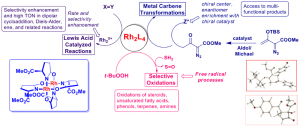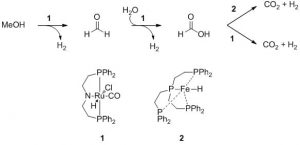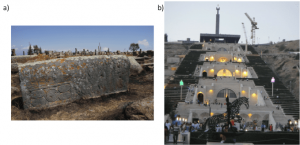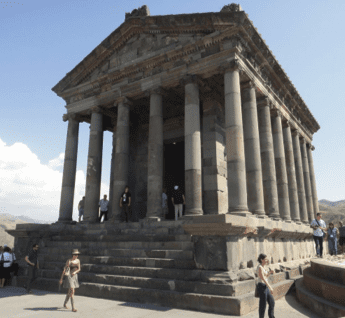By Wesley R. Browne and Anna K. H. Hirsch, Stratingh Institute for Chemistry, University of Groningen
With participants hailing from over 20 countries and representing even more nationalities, the first “Frontiers in Chemistry” conference held in Yerevan, Armenia, constituted a first visit for many, which goes a long way to explaining the great thirst and excitement with which not only the chemistry but also the culture and history were absorbed and digested by the delegates. Besides being a first visit to Armenia for many of us, the chairs of the conference, Prof. Syuzanna Harutyunyan and her colleague Prof. Ben L. Feringa (both from the University of Groningen, The Netherlands) together with Prof. Ashot S. Saghyan (Yerevan State University, Armenia) accomplished another première: Frontiers in Chemistry was also the first fully international chemistry conference to be held in Armenia and provided an unmissable opportunity for the six participants of the Armenian diaspora from top academic institutes to celebrate Armenian contributions to chemistry together with the chemistry community of the Caucasus.
In the full spirit of a broad-spectrum chemistry conference, the five-day program blended the rich diversity of the chemical sciences from the latest advances in materials science and tales of the risky business of total syntheses from the fields dare devils to the gentle recount by Shankar Balasubramanian of the odyssey from single-molecule spectroscopy to cracking life’s genomic enigma. The diversity and variety within each session ensured that all participants stayed tuned in spite of the lack of sleep from jetlag, long journeys and scientific discussions into the small hours of the night.
The full conference program can be found on the ArmChemFront.com website; however, to appreciate the success of the meeting we highlight here some of the contributions of the twelve plenary, seven keynote and 28 contributed lectures by experts in the field including five participants from industry (BASF, Lonza, TEVA Pharma and VITO).
Materials

Scheme 1. One-pot synthesis of platinum(II) complex 4 and a representation of the self-assembly process, going from luminescent aggregates to fibers and gels. a) Emission (—, λex=420) and excitation spectra (- - - -, λem=580) of the gel. Insets: Photographs of the luminescent gel. b) Top-view SEM image and c) TEM image of the gel. Image reproduced from reference 1.
Following a spectacular welcoming reception at the national art museum overlooking Yerevan, the conference kicked off on Monday morning with a welcome address by the deputy minister for foreign affairs of Armenia, Shavarsh Kocharyan, and the president of the Armenian National Academy of Sciences, Radik Martirosyan, followed by an exciting lecture on material science from Bert Meijer (Eindhoven University of Technology, The Netherlands), who captivated the audience during the opening lecture with a master class in complex systems. Luisa De Cola (University of Strasbourg, France) took up the baton showing how responsive materials, both hard and soft, can be used for the next generation of devices, illustrating how an impressive breadth of techniques enables her group to create smart materials and understand them all the way down to the molecular level, illustrated most strikingly by images of a molecular highway, in which the molecules are stuck in a traffic jam but remain nicely aligned inside the pores (Scheme 1).1 Not to be out-muscled by these titans of materials chemistry, Paul Weiss (University of California, Los Angeles, USA) captured the imagination of the audience through his passion for the design and meticulous study of nanoscale assemblies, and inspired us with a vision of assembling and operating molecules in a cooperative and hierarchical manner.
Total synthesis
Four power lectures on the risky business of modern total synthesis of natural products were kicked off by Scott Snyder (Columbia University and The Scripps Research Institute, USA) who played the right cards to achieve chemoselectivity in the face of molecular complexity. Eric Sorensen (Princeton University, USA) closed the first day with the sound of danger drums playing in the background as he recounted tales of the risks his group has taken in complex synthesis design (Scheme 2)2 and continued to beat drums right to the close of the conference!

Scheme 2. Eric Sorensen’s approach to the total synthesis of maoecrystal V, an anticancermetabolite from the Chinese medicinal herb Isodon Eriocalyx. TCM = traditional Chinese medicine. Image taken from reference 2.
Brian Stoltz (California Institute of Technology, USA) delivered the Novartis lecture promulgating the power of interdependence in driving advances in total synthesis and methodology.
Stephen Hanessian (University of Montreal, Canada), a scientific ambassador to Armenian diaspora in Canada and California, stayed on the synthetic track analysing the birth of a synthetic route from a psychobiological standpoint. His lecture revealing the intellectual journey taken by synthetic chemists in planning the most viable strategy was an eye-opener for both the younger and even not so young in the audience!
Catalysis and methodology

Scheme 3. Metal carbene-mediated transformations to generate a myriad of heterocycles. Image reproduced from reference 3.
Catalysis is at the heart of sustainable economies and was moved onto the center stage by Michael Doyle (University of Maryland, USA) during his journey through the development of rhodium catalysis. He highlighted the challenges we face along the long road to catch up with their power with non-scarce, metal-based catalysts and demonstrated how metal carbene-mediated transformations can generate a myriad of heterocycles (Scheme 3).3 It is certain that it will be quite some time before any of the attendees will use the term “carbenoid” again! Tamio Hayashi (National University of Singapore, Singapore) continued to showcase rhodium complexed with elegant chiral dienes constructed conveniently in one step and affording asymmetric conjugate addition reactions. Jerôme Lacour’s (University of Geneva, Switzerland) passion lies with ruthenium, which he coerces into assembling macrocyclic polyethers at high concentrations and in the absence of a template! He continued to stun us with the use of color to predict catalysis and live demonstrations with tomato juice. Helma Wennemers (ETH Zurich, Switzerland) raised the tempo a few notches with a firework display of organocatalysis showing how the right tripeptide can afford an array of products with exquisite stereocontrol. Herbert Mayr (Ludwigs-Maximilian Universität München, Germany) took us on a reflective tour of the fundamentals of organic chemistry and reminded us of the importance of systematic quantification that can be delivered by physical organic chemistry. The almost magical “Mayr scales” will certainly help not only the starting organic chemists predict the outcome of a synthetic transformation even when the functional groups are unknown.
Chemical biology

Scheme 4. Oxidative bisulfite sequencing allowing for quantitative sequencing at single-base resolution of 5-hydroxymethylcytosine. Image reproduced from reference 4.
Chemical biology was brought into focus by Shankar Balasubramanian (University of Cambridge, United Kingdom) with a lecture whose gentle delivery was matched by the awe of the audience at the speed of development and inspirational innovation in achieving rapid genome sequencing that all began with a quiet pint of beer with a physicist on a wet weekday afternoon. Shankar left us with a firm understanding of the yet bigger challenges ahead in unravelling epigenetic modifications and its importance, not least in oncology (Scheme 4).4 His colleague in “the other place!”, Ben Davis (University of Oxford, UK), followed his lead in a breathtaking display of the opportunities presented by the emerging field of synthetic biology and, in particular, the emergence of methods that allow us to modify proteins in a site-specific manner.

Scheme 5. Efficient low-temperature methanol and formic acid dehydrogenation processes mediated by ruthenium and iron complexes, respectively. Image reproduced from reference 5.
Sustainability
Sustainability and the use of non-scarce catalysts was the topic picked up on by Matthias Beller (University of Rostock, Germany), who presented a pragmatic roadmap to a sustainable future, conveying his vision of the major challenges to be addressed in the field and the central role played by catalysis from well-defined molecules to nanostructures (Scheme 5).5 In addition to being the conference Pan with his inspirational flute playing, Eiichi Nakamura (The University of Tokyo, Japan) closed the conference on this theme both by the promise of a new dawn in renewable energy based on future organic-based photovoltaic materials and by inspiring the next generation of chemists through a short anecdote on the origin of Umami. Eiichi, as well as illustrating how broad the interests of chemists can be closed the conference with a beautiful demonstration of the contribution chemistry can make to lay the foundation for industry to work towards a sustainable future.
Looking East
In addition to participants from Armenia (56 in total) and across the Caucasus, Eastern European countries were well represented both in the poster session and in keynote and contributed lectures. Contributions from Russia (3), Hungary (2), Poland (2) and the Czech Republic (1) as well as from Iran (1) highlight the challenges and developments being made in these regions to the modern chemical sciences. Four lecturers from the Armenian diaspora grasped the unique opportunity of being able to return to their home country and present their research in the context of an international conference. Davit Zargarian (University of Montreal, Canada), Patrick Shahgaldian (University of Applied Sciences and Arts, Northwestern Switzerland, Switzerland), Aleksander Sahakyan (University of Cambridge, United Kingdom) and, as mentioned above, Stephen Hanessian (University of Montreal, Canada).
Poster session
The poster session is the beating heart of any meeting and in Yerevan it was beating loudly with 74 posters covering a highly diverse range of topics, reflecting the diversity of the lectures. As with the constructive and stimulating atmosphere of the lecture hall, the poster session was characterized by lively discussions and a full attendance making it difficult for the poster judges to get a chance to talk with the many presenters! The poster jury, Clément Mazet (University of Geneva, CH), Maria Angeles Fernández-Ibañez (Universidad Autonoma de Madrid, E) and Anna K. H. Hirsch (University of Groningen, NL) had the challenging task to select the three winners of the poster prize, kindly supported by Wiley’s journal Particle & Particle Systems Characterization. The winners were selected after a heated discussion based on their merits in terms of the science presented, the quality of the discussion of the results as well as the aesthetics of the poster on display. Yohei Shimizu (The University of Tokyo, J), Karine V. Hakobyan (SPC “Armbiotechnology” NAS RA, ARM) and Jean-Baptiste Gualtierotti (EPFL, CH) received the first, second and third prizes, respectively.
Social program

Figure 1. a) Kchakars (cross-stones) at the Noratus cemetery, indicating that scientists (possibly chemists) were at work in Armenia already in the 10th century. b) Cafesjian Center for the Arts. Photographs taken by A. K. H. Hirsch and J. H. Kalter-Meuken.
The organisers managed somehow to fit in a social program that was as spectacular as the scientific part of the meeting with excursions to Lake Sevan, a visit of the Ancient Sevanavank monastic complex, Hayravank church and lunch at a traditional fish restaurant, Noratus cemetery: kchakars (cross-stones, Figure 1a), including one discovered by Helma Wennemers proving that chemists were at work in Armenia since the 10th century!
The welcome reception at Matenadran in Yerevan gave us our first glimpse of the long ecclesiastical history of Aremenia, with a guided tour of an impressive collection of ancient manuscripts hosted in a truly monumental building and a panoramic view of the city. What surprised many was that in addition to the beautifully illustrated Armenian manuscripts, a fifth of the manuscripts on display are in languages as diverse as Japanese and Ethiopian. The visit to this stunning collection was crowned by the welcome reception at the Cafesjian Center for the Arts (Figure 1b) on an airy terrace overlooking the city center where we enjoyed a long summer’s evening with plenty of local cuisine accompanied by jazz and a refreshing breeze.

Figure 2. a) Garni temple. b) Geghard monastery. Photographs taken by J. H. Kalter-Meuken and J. Rong.
The Wednesday afternoon excursion saw almost everyone (and with some gentle persuasion from the conference secretary Tineke Kalter-Meuken, everyone) make the journey to Garni and Geghard (Figure 2a). Garni is truly impressive because of its breathtaking location on a promontory overlooking a deep canyon, surrounded by tall mountains. The temple dates to the 1st century AD but had to be reconstructed by archaeologists in the 20th century after its destruction by an earthquake in the 17th century. A local musician used this venue to provide us with a first taste of the melancholic sounds of the traditional Armenian woodwind instrument, the duduk. A part of the delegation also admired the Roman bath house from the 3rd century. After a short bus ride, we literally hit the end of the road and found ourselves in front of a spectacular natural amphitheatre of cliffs providing the unique backdrop to the Geghard monastery, which is a UNESCO world heritage site for reasons immediately obvious to the delegates (Figure 2b)! What is remarkable about this monastery, which dates back to the 4th century, is that the chapels are carved into the surrounding mountains.
The conference ended with a spectacular outdoor conference banquet outside of Yerevan with a seemingly unending supply of local delicacies, traditional (and later some not so traditional) dancing and music both from local musicians and the attendees themselves playing drums and woodwind. Despite a very early start home for many of the delegates the buses departed for the hotel much later than planned – but with enough time to pack and head for the airport and home with a wonderful impression of a, too often, overlooked corner of the planet.
References
[1] C. A. Strassert, C.-H. Chien, M. D. Galvez Lopez, D. Kourkoulos, D. Hertel, K. Meerholz, L. De Cola, Angew. Chem. 2011, 123, 976–980; Angew. Chem. Int. Ed. 2011, 50, 946–950.
[2] E. J. Sorensen et al., unpublished results.
[3] a) X. Xu, Y. Qian, P. Y. Zavalij, M. P. Doyle, J. Am. Chem. Soc 2013, 135, 1244–1247, b) X. Xu, P. Y. Zavalij, M. P. Doyle, Angew. Chem. 2012, 124, 9967–9971; Angew. Chem. Int. Ed. 2012, 51, 9829–9833.
[4] M. J. Booth, M. R. Branco, G. Ficz, D. Oxley, F. Krueger, W. Reik, S. Balasubramanian, Science 2012, 336, 934–937.
[5] a) A. Boddien, D. Mellmann, F. Gartner, R. Jackstell, H. Junge, P. J. Dyson, G. Laurenczy, R. Ludwig, M. Beller, Science 2011, 333, 1733–1736, b)M. Nielsen, E. Alberico, W. Baumann, H.-J. Drexler, H. Junge, S. Gladiali, M. Beller, Nature 2013, 495, 85–89.














